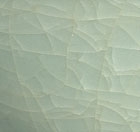J.J. Lally & Co., Oriental Art / New York City, New York
MenuPast Exhibition
The Gordon Collection:
Chinese Ceramics and Works of Art
March 12 - April 4, 2009
24.
A LONGQUAN CELADON CONICAL BOWL
Southern Song Dynasty (A.D. 1127-1279)
finely potted with straight flaring sides rising from a small ring foot, covered with a translucent glaze of pale bluish-green tone showing dense ‘ice-crackle’ throughout, pooling thicker around the underside of the rim and in the shallow recess around the small dome in the center of the bowl, the countersunk base also very gently domed and fully glazed, the edge of the foot left unglazed and the exposed stoneware burnt reddish-brown in the firing.
Diameter 5 1⁄2 inches (14 cm)
A Longquan bowl of this classic Song form in the Zhejiang Provincial Museum is illustrated in the catalogue of the loan exhibition from China shown at the Baur Foundation, Geneva, and the Cernuschi Museum, Paris, entitled Céladon Grès des Musées de la province du Zhejiang, Chine, Paris, 2005, no. 78, p. 179, described as a douli wan (hat-shaped bowl).
Another Longquan celadon bowl of very similar form in the Percival David collection is in the Illustrated Catalogue of Celadon Wares in the Percival David Foundation of Chinese Art, London, Rev. Ed. 1997, no. 231, p. 29. Another similar example in the Palace Museum, Beijing, is illustrated in Gugong Bowuyuan Cang Wenwu Zhenpin Quanji: Liang Song Ciqi, II (The Complete Collection of Treasures of the Palace Museum: Porcelain of the Song Dynasty, II), Vol. 33, Hong Kong, 1996, no. 137, p. 152.
Compare also the bowl of this type from a Japanese private collection illustrated in Sekai Toji Zenshu (Ceramic Art of the World), Vol. 12, Tokyo, 1977, col. pl. 212; and a slightly larger example from the collection of Rokuon-ji Temple, Kyoto, illustrated in the same volume, col. pl. 211.
南宋 龍泉青瓷碗 徑 14 厘米
